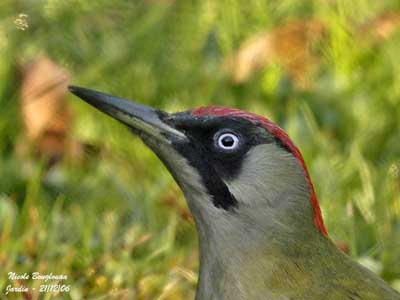
Eurasian Green Woodpecker
Picus viridis
Piciforme Order – Picidae Family
BIOMETRICS:
Length : 31-33 cm
Wingspan : 40-42 cm
Weight : 138-250 g
LONGEVITY: Up to 15 years
DESCRIPTION:
Eurasian Green Woodpecker is a beautiful bird whose laughing call often resounds through the forest.

Adult male has green plumage. Upperparts are bright yellow-green. Rump is bright yellow. Uppertail coverts are yellow with green bases. Uppertail feathers are blackish with green edges. Central pair shows some pale bars.
On the upperwings, we can see golden or bronze tinge on coverts and tertials, whereas primary feathers and their coverts are blackish with inner green edges. Several white spots form short black and white bars.
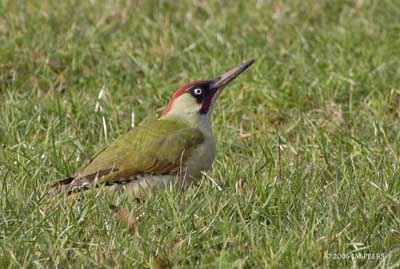
Underparts are pale yellow-green, becoming paler towards the lower belly. There are some weak bars from lower flank to undertail coverts.
Underwing is barred grey and white, with yellowish or greenish coverts.
On the head, crown is bright red from forehead to nape, with grey feather bases often visible. Bill base, lores and broad area around the eyes are black. We can see a conspicuous bright red malar stripe surrounded by a fine black line below this black area. Rear ear-coverts are pale greenish. Chin and upper throat are pale greyish.
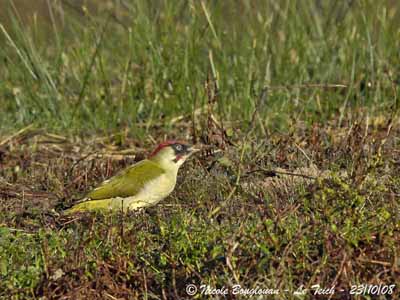
Long, pointed bill is dark grey to blackish, with paler base of lower mandible. Eyes are white with pinkish-white eye-ring. Short legs and zygodactylous feet are greenish-grey.
Female is similar but she has black malar stripe.
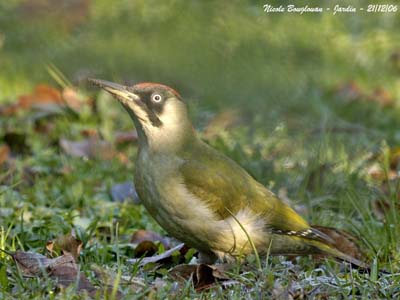
Juvenile is duller than adults with greyer eyes. Upperparts (including wings and tail) are spotted and barred white with duller yellow rump slightly barred. Underparts are pale greenish spotted black on breast, and barred black towards the belly.
Head is spotted and streaked grey on the red areas.
We can find five subspecies: P.v. viridis ; P.v. sharpei ; P.v. karelini ; P.v. vaillanti and P.v. innominatus.
These subspecies differ in bill size, intensity of colours and head pattern (mainly on the face).
VOICE: SOUNDS BY XENO-CANTO
Eurasian Green Woodpecker’s typical call is a laughing “klew-klew-klew-klew…” accelerating towards the end. The loud call of the male carries a great distance. The female’s call is less hard.
We can also hear some “kyack”, “kewk” or “kuk”, singly or in loose series.
The bird gives a rapid shrill “kyu kyu kyu kyuk” when excited.
Drumming is less frequent than in other woodpeckers’ species and lasts about one second.
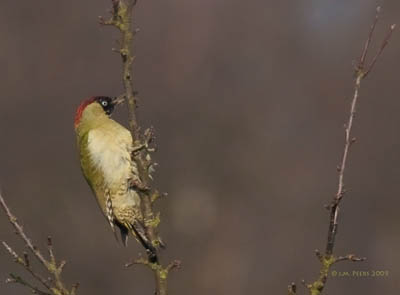
HABITAT:
Eurasian Green Woodpecker frequents woodlands with edges and clearings, both deciduous and conifers, according to the range. It is often seen in parks and urban areas, orchards, large gardens and open areas with scattered trees.
This species may be seen from sea-level up to 1500-3000 metres of elevation in mountain areas.
RANGE:
Eurasian Green Woodpecker is essentially resident in its range, from W Europe and North Africa, to W Asia.
BEHAVIOUR:
Ants are the favourite food of the Eurasian Green Woodpecker. It finds them in old pastures and heaths.
It extracts ants and pupae from the deep galleries, thanks to the stout bill and long tongue. This one may be extended up to 10 cm in order to explore the galleries. Preys are caught with the sticky tip.
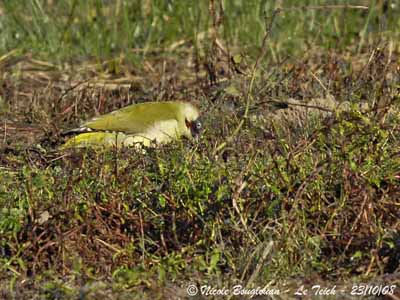
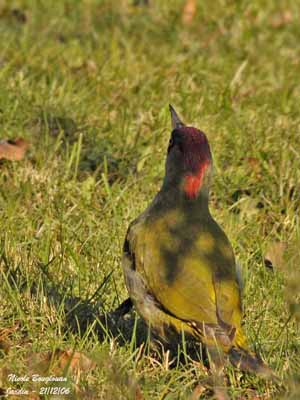
Eurasian Green Woodpecker also takes various insects, earthworms and snails, but plant matter such as fruits, berries and some seeds are also consumed. It forages on the ground, trunks, large branches and rocks.
This bird can be seen alone, in pairs or in family groups, when the young follow their parents after leaving the nest.
Eurasian Green Woodpecker is extremely shy, and more often heard than seen.
In spring, some courtship displays can be observed. Both mates perform aerial chases. Male feeds female during this period, and before copulation.
In other displays, crown and nape feathers are erected, head extended and bill pointed upwards or forwards at the intruder in territorial defence. Tail is spread and wings are often dropped while the male performs swinging movements of head and body. Usually, they do lateral movements while the bill describes circles or “8”.
This behaviour is performed when male and female meet, but also in aggressive displays with rivals.
Some aerial displays with various figures occur only between mates.
This species is usually resident in its range, with some local winter movements.
VOL:
Eurasian Green Woodpecker is able to fly very long distance if disturbed. When in flight, we can see the pointed tail and the bright yellow rump. The flight is undulating, as in most of woodpeckers.
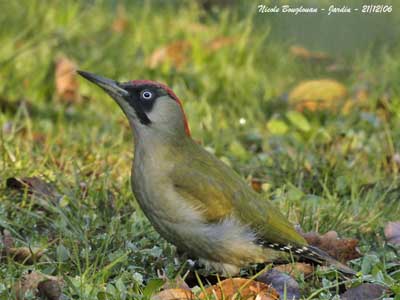
REPRODUCTION:
Breeding season occurs from Early April to June, but calling by male starts in December.
Eurasian Green Woodpecker breeds in cavities, a hole in tree or in large branch. Both male and female excavate the hole, and this work may last two to four weeks. The cavity is situated in dead tree or in soft living wood, at 2 to 10 metres above the ground.
The nest includes a circular or oval entrance, a tunnel, and the nest-chamber is dug into the soft part of the wood. The most part of the wood chips is removed from the hole with the bill. The floor of the nest is covered by wood chips.
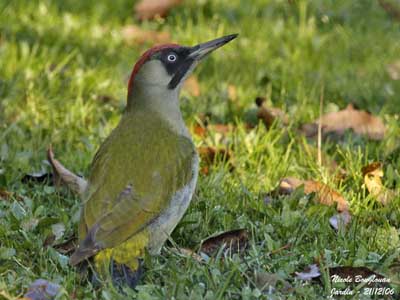
Female lays 5-8 eggs. Incubation lasts 14 to 17 days by both sexes. Male incubates mainly during the night. Chicks are fed by their parents by regurgitation. They fledge about 25 days after hatching. Young reach the close branches by flapping, or descend to the ground.
The brood is often divided between the two parents in order to feed the young. This period may lasts 3 to 7 weeks.
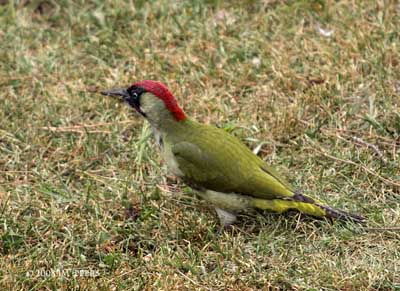
DIET:
Eurasian Green Woodpecker feeds mainly on ants and pupae. It also consumes various insects, earthworms, snails, fruits, berries and some seeds.
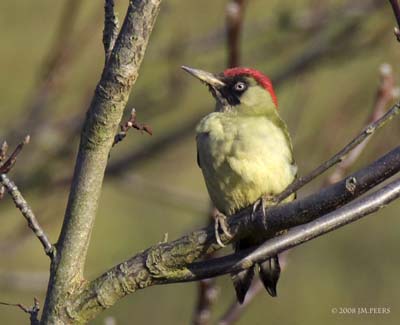
PROTECTION/ THREATS/STATUS:
Eurasian Green Woodpecker is common in its range. It is vulnerable to deforestation and changes in the habitat. However, this species is not globally threatened at this moment.
Fr : Pic vert ou Pivert
All : Grünspecht
Esp : Pito Real
Ital : Picchio verde
Nd : Groene Specht
Sd : Gröngöling
Photographers:
Eugène Montocchio (Pictures of the juvenile)
Galerie Photos Nature
Jean Michel Peers
JMPN PHOTOGRAPHIE
Other pictures and text by Nicole Bouglouan
Sources:
HANDBOOK OF THE BIRDS OF THE WORLD Vol. 7 by Josep del Hoyo-Andrew Elliott-Jordi Sargatal – Lynx Edicions – ISBN: 8487334377
THE HANDBOOK OF BIRD IDENTIFICATION FOR EUROPE AND THE WESTERN PALEARCTIC by Mark Beaman, Steve Madge - C.Helm - ISBN: 0713639601
THE COMPLETE BOOK OF BRITISH BIRDS – Written by “Royal Society for the Protection of Birds” experts - Préface de Magnus Magnusson - Michael Cady- Rob Hume Editors - ISBN: 0749509112
The Longevity List (Roland Staav)